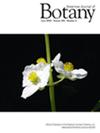Phylogenomics, historical biogeography, and diversification of leaf traits in the Malagasy-endemic genus Uncarina (Pedaliaceae)
Abstract
Premise
Uncarina contains 14 species of woody plants endemic to Madagascar. Its occurrence across dryland biomes on the island make it an interesting system to study the diversification of the flora.
Methods
Using samples of all species and 512 nuclear loci, we reconstructed phylogenetic trees to examine species relationships and assess their monophyly. We also studied the historical biogeography of the genus and combined leaf trait data derived from SEM photography of trichomes and geometric morphometric analysis of leaf shape to better understand its diversification across dryland biomes.
Results
Uncarina is monophyletic, and major clades showed a clear biogeographical signal. Leaf traits also corroborated relationships among major clades. Although most species are monophyletic, at least one cryptic species exists. Uncarina, like many arid-adapted plant lineages in Madagascar originated in the Miocene or Pleistocene. Geographic movement has been primarily along a south–north axis, with river basins apparently acting as barriers to gene flow. The evolution of leaf traits corroborated movement from the spiny thicket to the dry forest biome.
Conclusions
As with Malagasy lemurs and other animals, riverine barriers may have been involved in the diversification of Uncarina and may apply more broadly to epizoochorous angiosperms of Madagascar. Leaf traits suggest either a loss of adaptations to extremely arid, high irradiance environments or a release from herbivores. As is likely needed in other Malagasy lineages, more thorough population-level sampling and specimen collecting is needed to fully understand the taxonomic and morphological diversity in the genus.




 求助内容:
求助内容: 应助结果提醒方式:
应助结果提醒方式:


